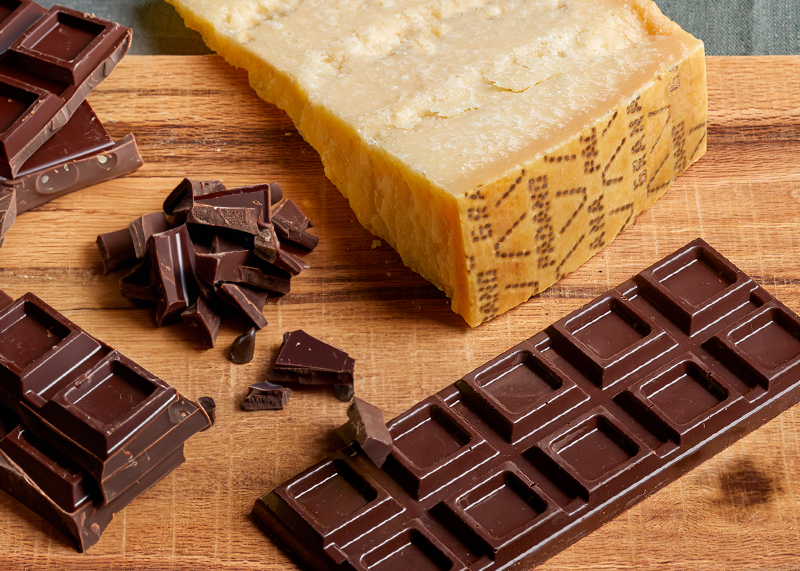
Grana Padano PDO “Riserva” aged over 24 months

Grana Padano PDO “Riserva” aged over 24 months and Candied ginger morsels dusted in cocoa powder
Candying fruit and flowers is a complex and time-consuming but very useful process because it allows the organoleptic characteristics of the product to be preserved and kept intact for long periods.
To make candied fruit – now widely used in pastry and chocolate making – either the whole fruit or its peel can be used (e.g. citrus peel is very common) or, as in our case, pieces (‘chunks’) of the ginger root. An essential prerequisite is that the processing does not alter the original aromatic component, which must be clearly distinguishable from fruit to fruit and must still reflect the scent of the fresh fruit.
Our suggestion is to pair Grana Padano PDO ‘Riserva’ aged over 24 months with ginger morsels dusted in cocoa powder: these offer an interesting sensory experience as the structure of the candied fruit is complemented by the cocoa, which melts and envelops the mouth, and at the same time the typical aroma of the ginger meets the barely perceptible bitterness of the cocoa powder.
We believe that this combination is a successful response to the far-from-easy ‘challenge’ of finding something fit to pair with the Grana Padano PDO ‘Riserva’ aged over 24 months, with its extremely intense and complex organoleptic characteristics. In fact, the aromatic richness of this type of Grana Padano PDO, which recalls the aromas of dried fruit, is perfectly complemented by the typical hints of ginger which in turn recall that hint of pleasant, delicate pungency typical of Grana Padano PDO ‘Riserva’ aged over 24 months.
In conclusion, we can say that this is a special pairing: thanks to the ginger it conveys ‘freshness’ and – after swallowing – it allows the Grana Padano PDO ‘Riserva’ aged over 24 months to be enhanced, prolonging its ‘scent’ and persistence in the mouth.
Curious facts:
- The history of ‘candied fruit’ began more than a thousand years ago: for centuries it was only considered a valuable medicine, then later, in the East, particularly in Mesopotamia and China, people begin using ‘candying’ to preserve roots and plants. The name ‘candied’ originates from the Arabic term ‘qandi’, which indicated the juice of the sugar cane. Over time, candied fruit acquired two distinct roles: on the one hand, it was the only way to preserve fruit for a long time and therefore became essential for sailors on long voyages who needed to maintain a balanced diet; on the other hand, it became a delicacy, an important ingredient in pastry making and was appreciated for its aesthetic value by aristocrats, who loved to adorn their tables with magnificent arrangements of various forms of candied fruit.
- The introduction of candied fruit into the Italian peninsula first passed through Sicily – then an ‘Arab fiefdom’ – which acted as a bridge between East and West; the first documented appearance of candied fruit in Italy dates back to the Baroque period when trays of Sicilian candied fruit appeared on the rich tables of the Campidoglio in 1513 to honour the visit of the Medici. Unfortunately, due to the complexity of the candying process, today many companies have started to produce candied fruits industrially, and this has often meant that the original taste, characteristic nature, and above all the high quality of the candied product, have been lost.

Grana Padano PDO “Riserva” aged over 24 months and Dark chocolate 90% cocoa
The bar of chocolate with 90% cocoa is certainly made for those who love strong and decisive, but not necessarily bitter flavours; in fact, it it worth remembering that the excessive presence of bitterness is, in reality, indicative of low quality; any hint of bitterness, linked to the higher percentage of cocoa, must always be pleasant and depends on the quality of the cocoa beans and, above all, the processing steps.
The Grana Padano PDO ‘Riserva’ aged over 24 months and the bar of chocolate with 90% cocoa are two products with a big personality: more than a match, here we are looking at a ‘fight in the ring’ where the opponents alternate their qualities and character, dodge one other but neither one overpowers the other, eventually shaking hands in a final whirlwind of emotions.
In this pairing, the intense aromatic components of both products come together in a stimulating way. After swallowing, the tannin contained in the cocoa plays an important role in ‘cleaning’ the mouth, thus preparing it for further tasting, which will certainly offer – to those who have the patience to ‘listen’ – new and surprising sensations.
The suggested pairing is definitely an appealing proposition for those in search of something new, special and intriguing..
Curious facts:
- It is not uncommon to find a percentage of dark chocolate among the ingredients of beauty products. In fact, its properties have been found to make the skin softer and more elastic, delaying the appearance of fine lines.
